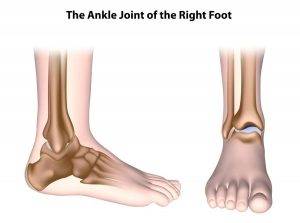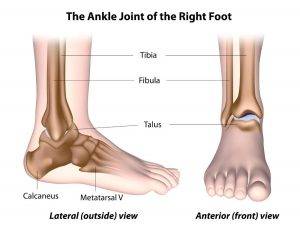Sprained your ankle, but it’s not getting better? Orthopaedic surgeon Dr Tan Ken Jin explores why this may be the case, and what can be done for your condition.
An ankle sprain can be common – almost everyone has experienced it at some point in their lives. Whether through sporting activity or just by walking on uneven surfaces, you may accidentally twist or roll your ankle, moving it out of its regular position and causing an injury.
In this video, Dr Tan Ken Jin from Orthosports Foot and Ankle Clinic at Mount Elizabeth Novena dives into the different types of ankle injuries, and some of the surgical treatments available for each type.
Ankle Injuries Overview
What is an Ankle Injury?
An ankle injury refers to any injury that occurs to the ankle joint, which connects the bones of the leg to the foot. Ankle injuries can range from mild to severe, and can affect the ligaments, tendons, bones, or other structures within the ankle joint.
In this article, we will be exploring more about ligament injuries, cartilage injuries and ankle fractures. Other types of ankle injuries can include muscle/tendon strains and ankle dislocations.
Ankle injuries can be caused by a variety of factors, including:
- Sudden impact / physical trauma
- Overuse
- Improper footwear, such as high-heels or loose-fitting shoes
- High-impact sports or activities, when one twists or rolls the ankle
Symptoms of an Ankle Injury
The symptoms of an ankle injury can vary depending on the type and severity of the injury. Common symptoms of an ankle injury include:
- Pain: The pain can range from mild to severe, and maybe a dull ache or sharp pain.
- Swelling
- Bruising
- Stiffness
- Difficulty walking or bearing weight
- Tenderness to the touch
Diagnosing an Ankle Injury
The symptoms of ankle injuries, be it a minor sprain or a fracture, can be very similar. That’s why it’s important to have an ankle injury evaluated by a doctor as soon as possible to understand the extent of the injury and start on appropriate treatment.
Here are the steps commonly taken to diagnose a ligament injury:
- Physical examination: Your doctor will perform a physical examination to assess the affected joint and check for symptoms such as pain, swelling, tenderness, and instability.
- Medical history: Your doctor will ask you questions about your medical history, including any previous injuries to the affected joint and any symptoms you’re experiencing.
- Imaging tests: Imaging tests such as X-rays, magnetic resonance imaging (MRI), and ultrasound may be used to confirm the diagnosis and determine the extent of the ligament injury.
- Functional testing: Your doctor may also perform functional tests to assess your range of motion, strength, and stability in the affected joint.
Based on the results of these tests, your doctor can determine the type and severity of the injury and recommend appropriate treatment options. If the injury is not too severe, quite often, an ankle brace and rehabilitative treatment may suffice.
However, if the symptoms are more severe or the injury appears more serious on the scans, surgery can be an effective way to restore the function of the ankle.
Ankle Ligament Injuries

Ligaments of the ankle (depicted as white bands in the illustration)
What is an Ankle Ligament Injury?
Ligaments are tough, fibrous bands of tissue that connect bones to other bones in a joint, providing stability and support. During a sudden twisting movement of the foot, the ankle ligament may be stretched beyond its limit and become injured.
Ankle ligament injuries can range from mild sprains to severe tears. Mild ligament injuries involve minor stretching or partial tearing of the ligament fibers, while severe injuries involve a complete tear of the ligament.
Symptoms of an Ankle Ligament Injury
A sprain is usually acute and happens abruptly when your ligament gets stretched and pulled. While many symptoms such as pain, swelling, and bruising are common to other ankle injuries, a ligament injury may also present with:
- Limited range of motion
- A ‘popping’ sound at the time of injury
- Instability
- The ankle feels achy after the activity
Treating Ankle Ligament Injuries
If the injury is not too severe, a brace or guard may be fit over the ankle, and rehabilitation of the ankle joint is done to regain range of motion, improve muscular strength and endurance and work the ankle back to normal walking and load-bearing.
Ankle ligament surgery may be required if symptoms persist despite conservative treatment. Minimally invasive procedures can be performed by an orthopaedic surgeon to repair or reconstruct torn ankle ligaments.
A keyhole incision is made to insert arthroscopic instruments to repair the ligaments. A tiny fish-hook-like equipment to hook the torn ligaments to pull them back to position. Suture tapes are used to secure torn ligaments. Anchors may also be used to hold the suture in place during ligament repair surgery. In some cases, implants may be used to provide additional stability.
The benefits of keyhole surgery for ankle ligament repair include smaller incisions, less scarring, less pain, and a faster recovery time compared to traditional open surgery.
After the surgery, the patient may need to wear a brace or cast to immobilize the ankle and allow the ligament to heal. They will also need to undergo physical therapy to regain strength and mobility in the affected ankle.
Ankle Cartilage Injuries

Ankle cartilage (depicted as pale blue material in between ankle bones)
What is a Cartilage Injury?
Cartilage is a tough, flexible tissue that covers the ends of bones and helps them move smoothly against each other while in motion. Compared to cartilage in larger joints of the hip, knee or shoulder, the cartilage in the ankle is quite thin. This makes it more susceptible to damage and injury. Furthermore, when articular cartilage is damaged, it does not repair itself as effectively as other tissues, limited by the lack of blood vessels and blood supply to create new cells.
The most common causes of cartilage defects are acute or chronic injuries such as ankle sprains, dislocations, fractures, or instability.
A cartilage injury occurs when there is damage to this tissue, often due to trauma or wear and tear over time. Cartilage injuries can range from minor tears to complete detachment from the bone.
There are two types of cartilage injuries:
- Traumatic injury: Traumatic cartilage injuries occur as a result of a sudden impact, such as a fall or a sports injury. This can cause the cartilage to tear or detach from the bone.
- Degenerative injury: Degenerative cartilage injuries occur over time as a result of wear and tear on the joint. This can cause the cartilage to become thinner and more prone to tearing.
Symptoms of a Cartilage Injury
Symptoms of a cartilage injury can be very similar to other types of ankle injuries. For cartilage injuries, one may experience:
- Persistent pain that feels “deep in the ankle”
- Clicking, jamming or locking sensation
Treating a Cartilage Injury
Treatment options for an ankle cartilage injury can vary depending on the location, size, and severity of the injury. Initial treatment typically involves a period of rest and activity modification to allow the cartilage to heal. Besides oral medication, intra-articular injections may be considered as the short-term option to reduce inflammation, ease pain, and improve joint lubrication.
When conservative treatment is not successful in improving the condition, surgery may be required to repair or replace the damaged cartilage. Some common surgical procedures include keyhole cartilage resurfacing, microfracture, osteochondral autograft transplantation, and autogenous chondrocyte implantation.
Keyhole Cartilage Repair/Resurfacing
Keyhole cartilage repair or resurfacing is a minimally invasive surgical technique used to repair damaged cartilage in the ankle joint. This procedure is often used to treat small to medium-sized cartilage defects.
During the procedure, a small incision is made in the knee joint, and specialized instruments and cameras are used to access the damaged area. Damaged cartilage is removed, and the area is resurfaced – reshaped to create a smooth surface.
Autogenous Chondrocyte Implantation
Autogenous or autologous chondrocyte implantation (ACI) is a procedure that involves harvesting cartilage cells (chondrocytes) from the patient’s own body and growing them in a laboratory, before reimplanting them into the patient’s affected joint.
These cartilage cells can be harvested by the use of a suction device combined with a net device to pull broken bits of cartilage out of the injured joint. These cells are cultivated in a lab before they are available for transplantation to patch up the defect in the cartilage.
Post-operative care is essential to ensure good results after the procedure. Immobilization with a brace and physical therapy can allow the new cartilage to heal and integrate with surrounding tissues.
Ankle Fractures
What is an Ankle Fracture?

Bones in the ankle
An ankle fracture is a break or cracks in one or more of the bones that make up the ankle joint. The ankle joint is made up of three bones: the tibia, fibula, and talus. An ankle fracture can occur in any of these bones and can range from a small crack to a complete break that causes the bones to become separated.
Symptoms of an Ankle Fracture
The symptoms of a sprain and of a fracture can be very similar – fractures can often be mistaken for sprains. With a fracture, the injured area may also:
- Look deformed or out of place
- Be tender to the touch
Contrary to popular belief, you may still be able to walk around with an ankle fracture. This depends on the location of the injury – if the fibula bone was fractured and the larger tibia bone is still intact, one may still be able to bear weight on the affected ankle. If you are still limping after some time of having an ankle sprain, you may have an undetected ankle fracture.
Treating an Ankle Fracture
Fractures can be treated either surgically or non-surgically.
A fracture can be treated non-surgically through the use of an ankle boot that immobilizes the ankle. This can be done for if only one ankle bone is broken, and if the bones are not out of place and the ankle is stable.
If the ankle is unstable, the fracture can be treated via surgical fixation. Internal fixation devices such as screws, plates or rods hold the bones in place while they heal. Screws are commonly used to hold the bones together, especially in smaller fractures. Plates are used to hold the bones together in larger fractures. Rods are used for fractures where the bone has been shattered into multiple pieces. Following the surgery, the ankle is immobilized with a cast or fracture boot during the healing process.
Conclusion
As you can see ankle sprains are not as simple as they seem! While often it may be a simple musculoskeletal injury, there is also a chance that the ligament, cartilage or even the bones of the ligament are affected at the point of injury.
These injuries can lead to ankle pain and instability and can become chronic if left untreated. Therefore, it is important to seek medical attention early if you experience ankle pain or discomfort. With proper diagnosis and treatment by an orthopaedic surgeon, you can prevent further damage and heal the injured ankle appropriately.
This article is supported by an educational grant.
